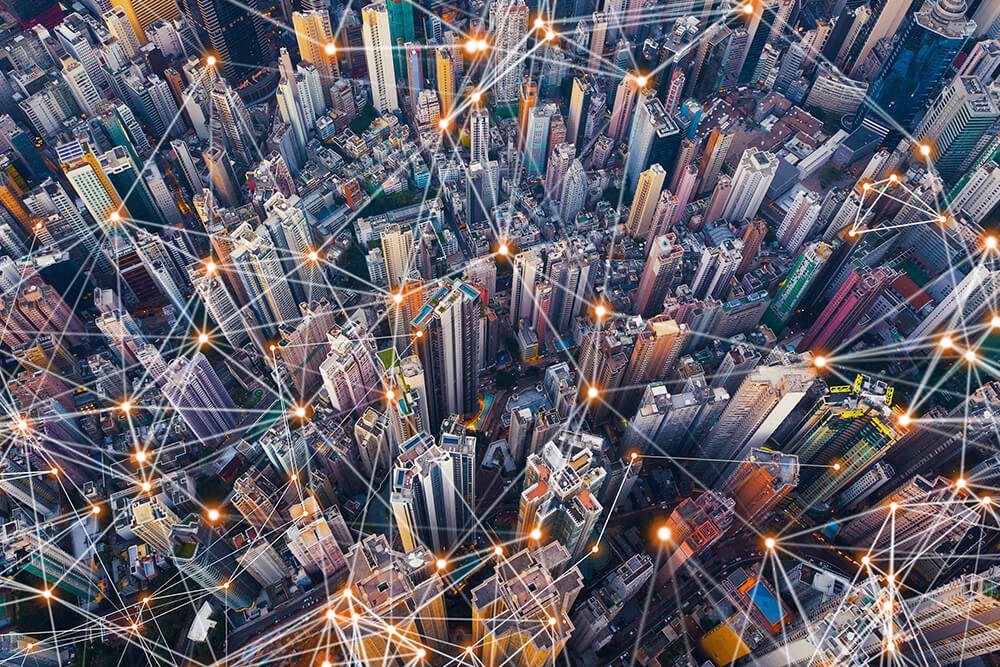With the development of AI, IoT, and Data Analytics, smart cities are focusing on improved quality of life & economic growth with enhanced sustainable living.
The concept of smart cities is rooted in interconnectivity, sustainability, and a lifestyle enhanced by technology. Remember when such a feeling seemed like a sci-fi fantasy; today, we are witnessing that vision unfold before our eyes. It is incredible to see how cities are transforming around us. Everything is changing. And fast too. The shift in the quality of life is undoubtedly there, whether in the form of data-driven infrastructure or environment-friendly energy systems. So, let’s also examine how we reached this moment, where we’re going, and what’s being built to carry us into the future.

Cities have always been about people. They began as small towns and have grown into mega hubs over the centuries. But that growth has not always been smooth. Overcrowding, pollution, traffic, and the housing crisis emerged as crucial problems. Eventually, we had to ask — how do we create cities that work for people?
That’s where smart cities came in. The earliest ideas go back to the 1990s, when the internet was kicking off. The idea was simple: deploy technology to make cities more efficient, connected, and sustainable. Sensors, data, and real-time feedback were the tools of the trade. Cities including Singapore and Barcelona led the charge, blending tech into everyday urban life.
Over time, the definition of a smart city has evolved. It wasn’t just about gadgets anymore. It became about the quality of life. A smart city now means cleaner air, better transport, quicker emergency response, and accessible services. It means cities that adapt and improve every single day. That shift—from tech-centered to people-centered—was huge. And it brought us to where we are now.
Right now, some of the most exciting urban projects are underway. What’s coming next is not just about tall buildings or shiny tech. It’s about intelligent planning. Cities are being designed with purpose and passion.
Take NEOM in Saudi Arabia, for example. It’s a $500 billion smart city project that’s redefining urban life. It promises zero cars, zero streets, and zero carbon emissions. Imagine commuting via AI-powered pods instead of cars or living in vertical layers inside a 170-kilometer mirrored line. It sounds unreal, but it’s already under construction.
Then there’s Telosa, the futuristic city dreamt up by billionaire Marc Lore. Planned for the American desert, Telosa focuses on open access to opportunity and sustainability. It’s all about community-owned land and public spaces. This is city planning that puts people first.
Meanwhile, cities like Toronto, Helsinki, and Seoul are pushing ahead with smaller-scale, but equally innovative upgrades. They’re rethinking traffic flow, optimizing energy use, and transforming public transport.
And it’s not just new cities. Existing ones are evolving too. In Paris, they’re turning roads into parks. In Singapore, vertical farming is reducing food miles. In India, the Smart Cities Mission is modernizing over 100 cities with better roads, lighting, and sanitation.
All of this shows that the future of urban development is already here. And it’s rooted in sustainability, equity, and connectivity.
What is the heart of a smart city? —The infrastructure, of course. This is where things get truly fascinating. We’re not just building roads and bridges. We’re building systems that think.
Take smart grids, for instance. These energy networks can adjust supply based on real-time demand. That means fewer blackouts and more efficient energy use. Solar panels, wind turbines, and battery storage are all being plugged into these smart grids. Clean, green energy is finally going mainstream.
Then there’s mobility. Remember when sitting in traffic felt normal? Those days are numbered. Smart cities are investing heavily in intelligent transport systems. Think electric buses that arrive on demand. Traffic lights that adjust based on flow. And bike lanes that connect seamlessly to public transit.
5G networks are also playing a major role. They’re powering everything from autonomous vehicles to smart streetlights. With ultra-fast speeds and low latency, 5G allows infrastructure to respond instantly. A broken water pipe? The system detects and alerts crews before it floods the street.
Heard about digital twins? These are virtual models of real cities. Planners can simulate everything—from how heat spreads on a summer day to how a building affects wind flow. It helps prevent problems before they happen.
Not to forget green buildings. They’re not only eco-friendly, but also smart. They regulate their temperature, harvest rainwater, and utilize natural light to minimize energy consumption. Some cities, like Amsterdam, are developing entire neighborhoods on circular principles, where nothing is thrown away, and everything is reused.
It’s difficult not to get caught up in the excitement because Smart cities are no longer a dream for the future. They’re being constructed, tested, and lived in now. By combining technology, sustainability, and human-centric design, the future is being reimagined. No doubt, we’re standing at the edge of a new era. One where our cities don’t just grow—they evolve. One where infrastructure isn’t just functional—it’s intelligent. Most importantly, one where people live better, safer, and more connected lives.
Obviously, Challenges remain. Privacy, affordability, and digital equity all need careful attention. But if we get this right, the rewards are immense. We have a chance to reshape the very way we live, move, and thrive in cities. The future isn’t just near—it’s being built. And I, for one, can’t wait to see where it takes us.